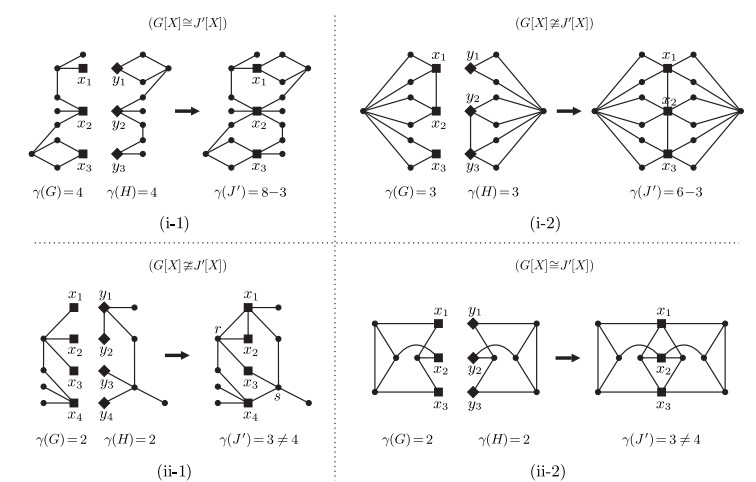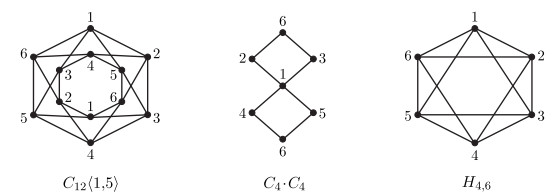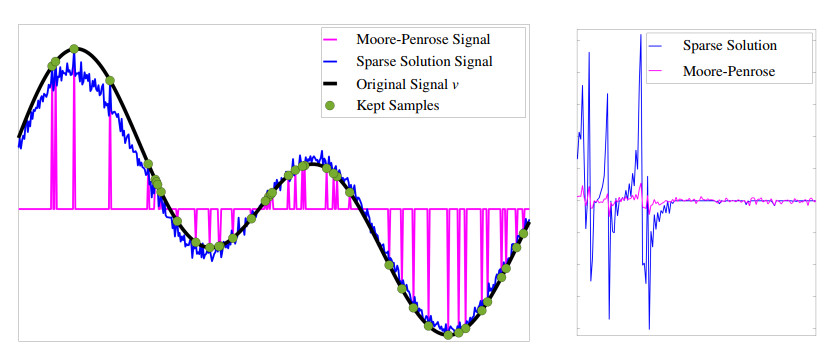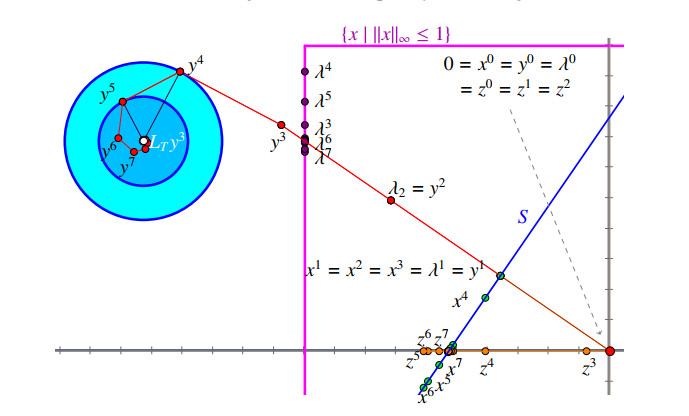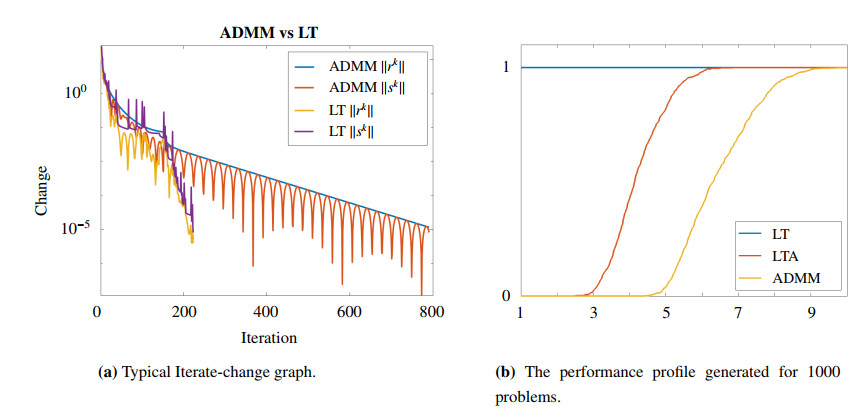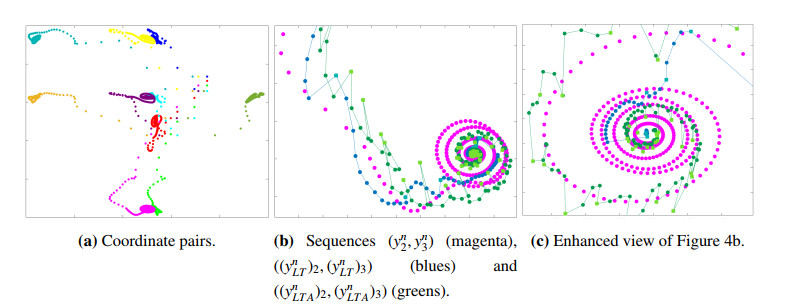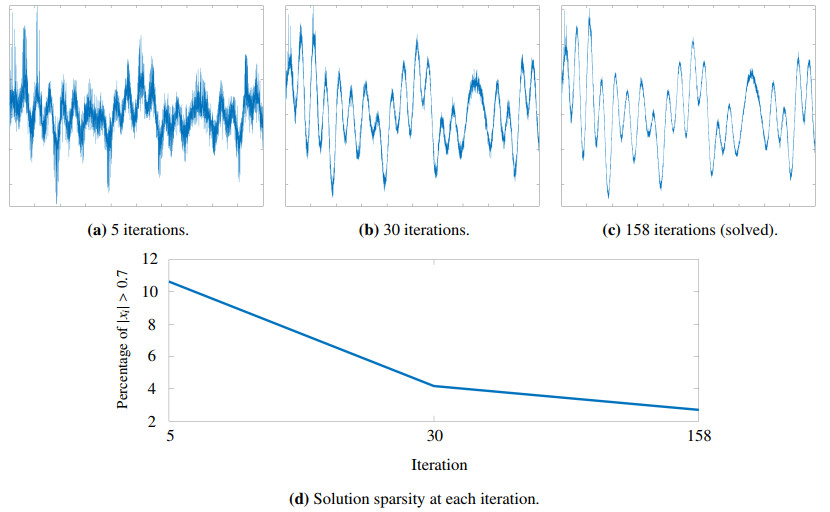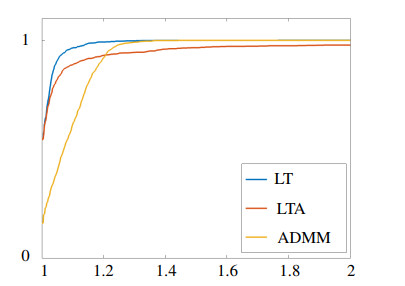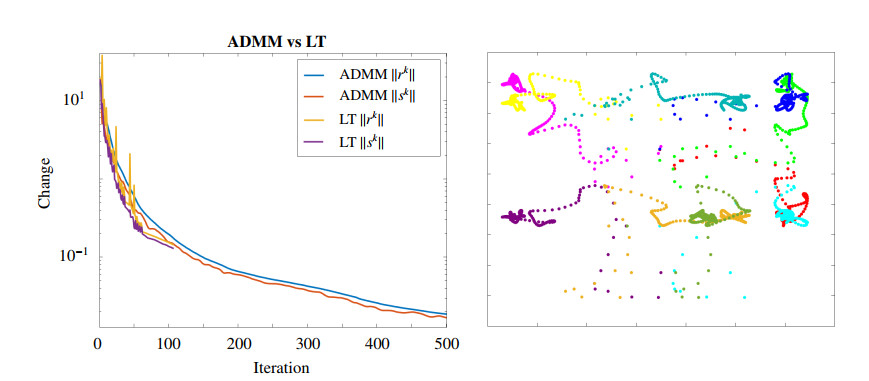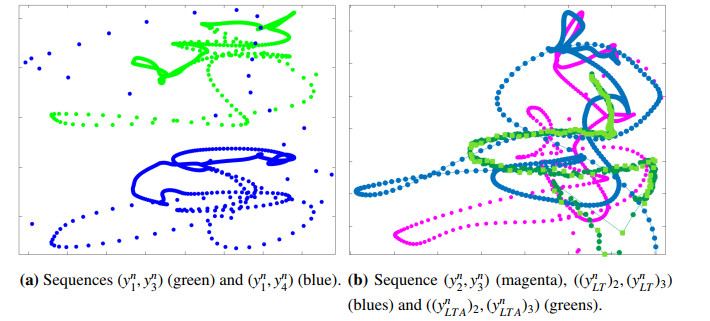1.
Introduction
The graphs considered in this paper are finite, undirected and simple. Let G be a graph with vertex set V(G) and edge set E(G). For any X⊆V(G), denote by G[X] the subgraph of G induced by X. For any u,v∈V(G), denote by dG(u,v) the distance from u to v in G as well as dG(v), NG(v) and NG[v] the degree, open neighborhood and closed neighborhood in G, respectively. Furthermore, for any U⊆V(G), the open and closed neighbourhood of U are defined as NG(U)=⋃v∈UNG(v) and NG[U]=NG(U)∪U, respectively. Two graphs G and H are disjoint if they have no vertices in common and no vertex of G is adjacent to any vertex of H. The union of graphs G and H is the graph G∪H with V(G∪H)=V(G)∪V(H) and E(G∪H)=E(G)∪E(H).
A set S⊆V(G) is called a 2-packing of graph G if dG(x,y)>2 for every pair of distinct vertices x,y∈S. A set D⊆V(G) is called a dominating set of G if every vertex of G is either in D or adjacent to a vertex of D. The domination number γ(G) is the cardinality of a minimum dominating set of G. We denote by MDS_(G) the set of all the minimum dominating sets. That is, MDS_(G)={D∣D is a minimum dominating set of G}.
Remark. We use the symbol MDS_ but not MDS, because MDS(G) has been defined to be the set of all the minimal dominating set of a graph G in the textbook [14].
1.1. Vertex-critical graphs and strong l-vertex-set-critical graphs
Definition 1.1. A vertex v∈V(G) is called a critical vertex of G if γ(G−v)=γ(G)−1.
Observation 1.2. For any v∈V(G),
Definition 1.3. A graph G is called vertex-critical if every vertex of G is critical.
The research on vertex-critical graphs was conducted in [4]. Afterwards, authors studied on its diameter [9], connectivity [1], existence of perfect matching [1,2,16] and factor critical property [2,22,23]. Interested reads could consider the existence of irregular dominating set on vertex-critical graphs [7,18].
Furthermore, based on the right and the left of Formula (1.1), Brigham et al. [5] and Phillips et al. [21] extended the notion of vertex-critical graphs by introducing (γ,k)-critical graphs and (γ,t)-critical graphs, respectively.
Definition 1.4. [5] A graph G is called (γ,k)-critical if γ(G−S)<γ(G) for every S⊆V(G) with |S|=k.
Definition 1.5. [21] A graph G is called (γ,t)-critical if γ(G−S)=γ(G)−t for every 2-packing S of G with |S|=t.
In Definition 1.4, if k=2, then G is called domination bicritical. For more information of (γ,k)-critical or domination bicritical graphs, readers are suggested to refer to [8,10,11,17,19,20].
Now, again based on the left of Formula (1.1), we introduce the definition of strong critical vertex-set to extend the notion of critical vertex in the following Definition 1.1′. (It is easy to get that a strong critical vertex-set of G is also a 2-packing of G.) To compare Observation 1.2 and Definition 1.3, we give Observation 1.2′ and Definition 1.3′, and then we introduce Definition 1.6 with a remark.
Definition 1.1′. [25] A set S⊆V(G) is called a strong critical vertex-set (or just st-critical vertex-set for short) of G if γ(G−S)=γ(G)−|S|.
Observation 1.2′. For any S⊆V(G), γ(G−S)=γ(G)−|S|⇔γ(G−S)≤γ(G)−|S|.
Definition 1.3′. A graph G is called strong l-vertex-set-critical if V(G) can be partitioned into l non-empty strong critical vertex-sets of G.
Definition 1.6. Let S1,S2,…,Sl be non-empty strong critical vertex-sets of G. If {S1,S2,…,Sl} is a partition of V(G), then we call {S1,S2,…,Sl} or S1∪S2∪⋯∪Sl as a strong critical vertex-set partition of G.
Lemma 1.7. [25] A subset of an st-critical vertex-set of G is still an st-critical vertex-set of G.
Remark. Let S1=S11∪S21 with S11,S21≠∅. According to Definition 1.6 and Lemma 1.7, if S1∪S2∪⋯∪Sl is an st-critical vertex-set partition of G, then S11∪S21∪S2∪⋯∪Sl is also an st-critical vertex-set partition of G. Thus, in general, if G is a strong l-vertex-set-critical graph, then it may also be a strong j-vertex-set-critical graph for any l≤j≤|V(G)|.
1.2. On strong critical vertex-set and two-colored γ-set
When we talk about st-critical vertex-sets, we would like to mention another related notion---Two-colored γ-set. The present authors think that both of them are important on the problem of building family of graphs that make the equality hold in Vizing's Conjecture [15,25].
Definition 1.8. [15] Let D∈MDS_(G). D is called a two-colored γ-set of G if D partitions as D=D1∪D2 such that V(G)−NG[D1]=D2 and V(G)−NG[D2]=D1.
In Definition 1.8, since V(G)−NG[D1]=D2, we can deduce that D1∈MDS_(G−D2). So γ(G−D2)=|D1|=|D|−|D2|=γ(G)−|D2|, which implies that D2 is an st-critical vertex-set of G, and so is D1 symmetrically. Because two-colored γ-set is not the motif of this paper, we just introduce a proposition and a conjecture about it below.
Proposition 1.9. [15] If G is a generalized comb and H has a two-colored γ-set, then γ(G◻H)=γ(G)γ(H).
Conjecture 1.10. [13] If G is a connected bipartite graph such that V(G) can be partitioned into two-colored γ-sets, then G is the 4-cycle or G can be obtained from K2t,2t by removing the edges of t vertex-disjoint 4-cycles.
In Proposition 1.9, "◻" represents the cartesian product and a nontrivial connected graph G is called a generalized comb if each vertex of degree greater than one is adjacent to exactly one 1-degree-vertex of G. Conjecture 1.10 tries to give a necessary condition for a connected bipartite graph whose vertex set can be partitioned into two-colored γ-sets. Note that if a graph can be partitioned into k two-colored γ-sets, then it can partitioned into 2k domination critical vertex-sets.
At last, we sketch the coming two sections. To extend the previous concept---Vertex coalescence, we introduce the concept of vertex-set coalescence and give two theorems about it in Section 2, which are fundamental results of strong l-vertex-set-critical graphs. Let Cl={G∣G is a strong l-vertex-set-critical connected graph}. We will obtain that Cl≠∅ if and only if l∉{2,3,5} in Section 3.
2.
Vertex coalescence and vertex-set coalescence
Brigham et al. [4] studied on the vertex-critical graphs, and listed the following Theorems 2.2 and 2.3 without proofs because they thought the proofs are cumbersome but straightforward. In order to state these two theorems, we have to introduce the notion of vertex coalescence first. (Readers who want to know the concept of edge coalescence can refer to [12].)
Definition 2.1. [4,15] Let G and H be two disjoint graphs with x∈V(G) and y∈V(H). The vertex coalescence G⋅xyH (or just G⋅H if x and y are arbitrary) of G and H via x and y, is the graph obtained from the union of G and H by identifying x with y. (Refer to Figure 1.)
Agreement. In this section, when identifying x with y, we choose x but y to represent the identified vertex in the resulting graph.
Theorem 2.2. [4] Let G and H be two disjoint graphs, and let G⋅H be any vertex coalescence of G and H. Then γ(G)+γ(H)−1≤γ(G⋅H)≤γ(G)+γ(H). Furthermore, if both G and H are vertex-critical or G⋅H is vertex-critical, then γ(G⋅H)=γ(G)+γ(H)−1.
Theorem 2.3. [4] The graph G⋅H is vertex-critical if and only if both G and H are vertex-critical.
To compare Brigham's results, we give the corresponding results on strong l-vertex-set-critical graphs one to one (see Definition 2.1′, Theorems 2.2′ and 2.3′). For the mathematical rigor, we are going to prove them without the supporting of Theorems 2.2 and 2.3, where in fact, our proofs include the derivation of Brigham's results. Before this, we need to introduce the definition of "compatible" and two lemmas.
Definition 2.4. Let G be a graph with x,y∈V(G). x and y are called compatible in G if there exists D0∈MDS_(G) such that {x,y}⊆D0, and incompatible in G if |{x,y}∩D|<2 for any D∈MDS_(G).
Lemma 2.5. [6] Let G be a graph with x,y∈V(G), and G′ be the graph obtained from G by identifying the two vertices x and y. Then γ(G′)<γ(G) if and only if x and y are compatible or at least one of x and y is critical in G.
Lemma 2.6. Let J be a graph with x,y∈V(J), and J′ be the graph obtained from J by identifying the two vertices x and y. Then γ(J)−1≤γ(J′)≤γ(J) with the second equality holds if and only if x and y are incompatible and neither x nor y is critical in J.
Proof. Let D′∈MDS_(J′). Then D′∪{y} is a dominating set of J, and so γ(J)≤|D′∪{y}|≤γ(J′)+1, which implies that γ(J)−1≤γ(J′). Let D∈MDS_(J) and
Then D′0 is a dominating set of J′, and so γ(J′)≤|D′0|≤|D|=γ(J).
Now, since γ(J′)≤γ(J), it follows from the contrapositive of Lemma 2.5 that γ(J′)=γ(J) if and only if x and y are incompatible and neither x nor y is critical in J. □
Definition 2.1′. Let G and H be two disjoint graphs with ∅≠X⊆V(G), ∅≠Y⊆V(H) and |X|=|Y|. Let X={x1,x2,…,xm} and Y={y1,y2,…,ym}. The vertex-set coalescence G⋅XYH of G and H via X and Y, is the graph obtained from the union of G and H by identifying xi with yi for every 1≤i≤m. (Refer to Figure 2.)
Theorem 2.2′. Let G and H be two disjoint graphs with ∅≠X⊆V(G), ∅≠Y⊆V(H) and |X|=|Y|. Let G∘ and H∘ be the subgraphs of G⋅XYH induced by V(G) and V(H−Y)∪X, respectively. Then
(a) γ(G)+γ(H)−|X|≤γ(G⋅XYH)≤γ(G)+γ(H). Furthermore, the first equality holds if X is an st-critical vertex-set of G or there exists ˜DG∈MDS_(G) and ˜DH∈MDS_(H) such that X⊆˜DG and Y⊆˜DH; the second equality holds only if DG∘∩DH∘=∅ for any DG∘∈MDS_(G∘) and DH∘∈MDS_(H∘).
(b) X and Y are st-critical vertex-sets of G and H respectively if and only if X is an st-critical vertex-set of G⋅XYH;
(c) if X is an st-critical vertex-set of G⋅XYH, then γ(G⋅XYH)=γ(G)+γ(H)−|X|.
Proof. (a) Firstly, let D′∈MDS_(G⋅XYH), B1 and B2 be the subsets of X which can not be dominated by D′∩V(G∘) and D′∩V(H∘) in G and H, respectively. Then (D′∩V(G∘))∪B1 and (D′∩V(H∘))∪B2 are dominating sets of G and H, respectively. Since D′∈MDS_(G⋅XYH), it follows that the vertices of X not dominated by D′∩V(G∘) in G must be dominated by D′∩V(H∘) in H, and the converse is also true. Thus B1∩B2=∅. Now, we have γ(G)+γ(H)≤|(D′∩V(G∘))∪B1|+|(D′∩V(H∘))∪B2|=|D′|+|D′∩X|+|B1|+|B2|≤γ(G⋅XYH)+|X|, which implies that γ(G)+γ(H)−|X|≤γ(G⋅XYH). Secondly, let DG∘∈MDS_(G∘) and DH∘∈MDS_(H∘). Since G and H are spanning subgraphs of G∘ and H∘ respectively, it follows that γ(G⋅XYH)≤|DG∘∪DH∘|≤γ(G∘)+γ(H∘)≤γ(G)+γ(H).
Furthermore, if X is an st-critical vertex-set of G, then γ(G⋅XYH)≤γ(G∘−X)+γ(H∘)≤γ(G−X)+γ(H)=γ(G)−|X|+γ(H), which implies that γ(G⋅XYH)=γ(G)+γ(H)−|X|; if there exists ˜DG∈MDS_(G) and ˜DH∈MDS_(H) such that X⊆˜DG and Y⊆˜DH, then γ(G⋅XYH)≤|(˜DG−X)∪˜DH|=|˜DG|−|X|+|˜DH|=γ(G)+γ(H)−|X|, which also implies that γ(G⋅XYH)=γ(G)+γ(H)−|X|. Meanwhile, if γ(G⋅XYH)=γ(G)+γ(H), then from γ(G⋅XYH)≤|DG∘∪DH∘|=|DG∘|+|DH∘|−|DG∘∩DH∘|≤γ(G∘)+γ(H∘)−0≤γ(G)+γ(H), we obtain that DG∘∩DH∘=∅.
(b) (⇒) Let D−G∈MDS_(G−X) and D−H∈MDS_(G−Y). Then D−G∪D−H is a dominating set of G⋅XYH−X. So γ(G⋅XYH−X)≤|D−G∪D−H|=γ(G)−|X|+γ(H)−|Y|=γ(G)+γ(H)−2|X|. By Item (a), we have γ(G)+γ(H)−2|X|≤γ(G⋅XYH)−|X|. By Observation 1.2′, X is an st-critical vertex-set of G⋅XYH.
(⇐) We are going to prove the sufficiency by induction on |X|. When |X|=1, we let X={x}, Y={y} and J=G∪H. If γ(G⋅xyH)=γ(G)+γ(H), then by Lemma 2.6, neither x nor y is critical in J. Thus γ(G)+γ(H)−1=γ(G⋅xyH)−1=γ(G⋅xyH−x)=γ(G−x)+γ(H−y)≥γ(G)+γ(H), a contradiction. So we have γ(G⋅xyH)=γ(G)+γ(H)−1 by Item (a). Thus γ(G)−1+γ(H)−1=γ(G⋅xyH)−1=γ(G⋅xyH−x)=γ(G−x)+γ(H−y)≥γ(G)−1+γ(H)−1, from which we have γ(G−x)=γ(G)−1 and γ(H−y)=γ(H)−1, and so the sufficiency holds.
Suppose that the sufficiency holds when |X|=n (n≥1). We consider the case when |X|=n+1 below. Let x∈X, y∈Y, X0=X−{x}, Y0=Y−{y}, J=G⋅X0Y0H and J′=G⋅XYH. Let D1∈MDS_(G−X), D2∈MDS_(H−Y) and D′=D1∪X∪D2. Since X is an st-critical vertex-set of J′, it follows that D′∈MDS_(J′). Also, D′ is a dominating set of J−y. So γ(J−y)≤|D′|=γ(J′). By Definition 1.1 and Lemma 2.6, we have
from which we know γ(J−y)≥γ(J′). Thus γ(J−y)=γ(J′). Therefore γ((J−y)−X)=γ(G−X)+γ(H−Y)=γ(J′−X)=γ(J′)−|X|=γ(J−y)−|X|, which implies that X is, and so X0 is, an st-critical vertex-set of J−y. Since γ((J′−X0)−x)=γ(J′−X)=γ(J′)−|X|=γ((J′)−|X0|)−|{x}|=γ(J′−X0)−1, we have x is a critical vertex of J′−X0. Note that J−y=G⋅X0Y0(H−y) and J′−X0=(G−X0)⋅xy(H−Y0). By the inductive hypothesis, we have that X0 is an st-critical vertex-set of G and x is a critical vertex of G−X0. Hence γ(G−X)=γ((G−X0)−x)=γ(G−X0)−1=γ(G)−|X0|−1=γ(G)−|X|. That is to say, X is an st-critical vertex-set of G. Symmetrically, one can prove that Y is an st-critical vertex-set of H. Thus the result is true when |X|=n+1. Item (b) follows.
(c) It is an immediate result of Items (b) and (a). □
Remark for Theorem 2.2′(a). Let J′=G⋅XYH. In this item, we give a sufficient condition for γ(G)+γ(H)−|X|=γ(J′) and a necessary condition for γ(J′)=γ(G)+γ(H). However, neither of them is sufficient and necessary condition. Here, we give the counter examples.
(I) As shown in Figure 3(i-1) and (i-2), we have γ(G)+γ(H)−|X|=γ(J′), but X is not an st-critical vertex-set of G and X⊈DG for any DG∈MDS_(G).
(II) As shown in Figure 3(ii-1), we have {r,x4} and {s,x1} are unique minimum dominating sets of G∘ and H∘ respectively, and {r,x4}∩{s,x1}=∅, but γ(J′)≠γ(G)+γ(H); and in (ii-2), we have DG∘∩DH∘=∅ for any DG∘∈MDS_(G∘) and DH∘∈MDS_(H∘) (because X∩DG∘=∅ for any DG∘∈MDS_(G∘)), but γ(J′)≠γ(G)+γ(H).
Theorem 2.3′. Let G and H be two disjoint graphs. Let ∅≠Xi⊆V(G) for i=1,2,…,k and ∅≠Yj⊆V(H) for j=1,2,…,l with |X1|=|Y1|. Then {X1,X2,…,Xk} and {Y1,Y2,⋯,Yl} are st-critical vertex-set partitions of G and H respectively if and only if {X1,X2,…,Xk,Y2,Y3,…,Yl} is an st-critical vertex-set partition of G.X1Y1H.
Proof. Let X={X1,X2,…,Xk}, Y={Y1,Y2,⋯,Yl} and X.Y={X1,X2,…,Xk,Y2,Y3,…,Yl}.
(⇒) Clearly, X.Y is a partition of V(G⋅X1Y1H). For any S∈X.Y, we have S∈X or S∈Y. If S∈X, then by Theorem 2.2′(c), we have γ(G⋅X1Y1H−S)≤γ(G−S)+γ(H−Y1)=γ(G)−|S|+γ(H)−|X1|=γ(G⋅X1Y1H)−|S|. Similarly, we can also prove that γ(G⋅X1Y1H−S)≤γ(G⋅X1Y1H)−|S| if S∈Y. The necessity follows.
(⇐) Clearly, X and Y are partitions of V(G) and V(H), respectively. Firstly, by Theorem 2.2′ (b), X1 and Y1 are st-critical vertex-sets of G and H, respectively. Secondly, for any S∈X−{X1}, we let ˙D−∈MDS_(G⋅X1Y1H−S), L=X1−(X1∩˙D−) and LG be the subset of L that can be dominated by ˙D−∩V(G) in G⋅X1Y1H. Let H∘ be the subgraph of G⋅X1Y1H induced by V(H−Y1)∪X1. Then ˙D−∩V(G) and ˙D−∩V(H∘) are dominating sets of (G−S)−(L−LG) and H∘−LG, respectively. So
By the forth equality, we have γ(G−S)=γ(G)−|S|. Thirdly, for any S∈Y−{Y1}, we can similarly prove that γ(H−S)=γ(H)−|S|. From these three observations, the sufficiency follows. □
3.
Existence of strong l-vertex-set-critical graphs with fixed l
In this section, we write dG(∗)=d(∗), NG(∗)=N(∗), NG[∗]=N[∗] and D−G=D−, as well as C4⋅C4=(C4)2, C4⋅C4⋅C4=(C4)3 and so on for belief.
Lemma 3.1. [25] An st-critical vertex-set of a graph G is a 2-packing of G.
Lemma 3.2. [24] If d(u)=1 and v∈N(u), then v is not a critical vertex of G. (This implies that a vertex-critical graph has no vertices of degree one.)
Lemma 3.3. [25] Let S be an st-critical vertex-set of G. If D−∈MDS_(G−S), then |D−|=γ(G)−|S| and D−∩N(S)=∅.
Lemma 3.4. Let S be an st-critical vertex-set of G and w∈V(G−S).
(a) If z∈N(w)∩S, then there exists v0∈N(w)−{z} such that N(v0)∩S=∅.
(b) Let uvwz be a path or a cycle in G(i.e. u=z is possible). If u,z∈S, then d(w)>2.
(c) Let X=N(w). If 2≤|X|≤3 and N(x)∩S≠∅ for every x∈X, then |N(X)∩S|=1.
(d) Let uvwyz be a trail in G. If u,z∈S and d(w)=2, then u=z.
Proof. (a) Suppose to the contrary that N(v)∩S≠∅ for every v∈N(w)−{z}. Then N[w]−{z}⊆N(S). By Lemma 3.3, there exists D−∈MDS_(G−S) such that D−∩(N[w]−{z})=∅. However, we see that D− can not dominate w in G−S, a contradiction.
(b) It is an immediate result of Item (a).
(c) Suppose to the contrary that |N(X)∩S|≠1. By Lemma 3.1, we have |N(X)∩S|≤|X|. This implies |N(X)∩S|=2 or 3. Let {r,s}⊆N(X)∩S. Then N(r)∩N(s)=∅. So we must have that at least one of r and s, say r, is adjacent to only one element of X. Thus we may suppose that {r}=N(x′)∩S, where x′∈X. Note that N(x)∩S≠∅ for every x∈X implies X⊆N(S). By Lemma 3.3, there exists D−∈MDS_(G−S) such that D−∩X=∅ and |D−|+|S|=γ(G). In order to dominate w in G−S, we have w∈D−. However, (D−−{w})∪(S−{r})∪{x′} is a dominating set of G with cardinality γ(G)−1, a contradiction.
(d) It is an immediate result of Item (c). □
Theorem 3.5. There exists a connected graph G such that V(G) can be partitioned into l strong critical vertex-sets if and only if l∉{2,3,5}.
Proof. (⇐) Let k∈Z+ and H4,8 be the (Harary) graph as shown in Figure 1. Based on the fact that Z+−{2,3,5}={1}∪{3k∣k≥2}∪{3k+1∣k≥1}∪{3k+2∣k≥2}, we let
Noting that V(C4) and V(H4,8) can be partitioned into 4 and 8 st-critical vertex-sets respectively, we can recursively deduce that V((C4)k) and V(H4,8⋅(C4)k−2) can be partitioned into 3k+1 (k≥1) and 3k+2 (k≥2) st-critical vertex-sets respectively by Theorem 2.3′. Also, note that V((C4)2) can be partitioned into 6 st-critical vertex-sets. So V((C4)k) can be partitioned into 3k (k≥2) st-critical vertex-sets. The sufficiency follows.
(⇒) Suppose to the contrary that l∈{2,3,5}. If l=2, then by Lemma 3.1, we get that d(h)=1 for every h∈V(G), which implies that G≅K2, contradicting the fact that K2 is not a vertex-critical graph. If l=3, then by Lemmas 3.2 and 3.1, we deduce that d(h)=2 for every h∈V(G), which implies that G is a cycle. However, one can check that this is impossible. (According to the two well-known facts that γ(Cn)=⌈n3⌉ and γ(Pn)=⌈n3⌉, we can easily deduce that a cycle of order at least 4 can not own an st-critical vertex-set of cardinality 2.)
If l=5, then we let V(G)=S1∪S2∪S3∪S4∪S5 be an st-critical vertex-set partition of G. By Lemmas 3.2 and 3.1, we have that 2≤d(g)≤4 for every g∈V(G).
Claim 1. Let {j,k,l,m,n}={1,2,3,4,5}. If N(sn)={sj,sk,sl}, where si∈Si for every i∈{j,k,l,n}, then |N({sj,sk,sl})∩Sm|=1.
For convenience, suppose without loss of generality that (j,k,l,m,n)=(1,2,3,4,5). We use reduction to absurdity. Assume that |N({s1,s2,s3})∩S4|≠1. Then since
by the contrapositive of Lemma 3.4(c), at least one of s1, s2 and s3, say s1, satisfies N(s1)∩S4=∅. Thus N(s1)−{s5}⊆S2∪S3. To combine this with Lemma 3.4(b), we must have d(s1)≠2, which implies that d(s1)=3. So N(s1)∩S2≠∅ and N(s1)∩S3≠∅.
Since s1∈N(s5)∩S1, by Lemma 3.4(a), one of N(s2)∩S1 and N(s3)∩S1, say N(s2)∩S1, is empty set. By Lemma 3.1, we have (N(s2)−{s5})∩(S2∪S5)=∅. Since s3∈N(s5) and N(s1)∩S3≠∅, by Lemma 3.4(a), we obtain that N(s2)∩S3=∅. So by Lemma 3.2, we have N(s2)∩S4≠∅. Let N(s2)∩S4={s4}. Then
So we have N(s4)∩S5=∅ by the contrapositive of Lemma 3.4(b). Thus N(s4)−{s2}⊆S1∪S3. Since d(s2)=2, we have s4s3∈E(G) or s4s1∈E(G) by Lemma 3.4(d). However, we have supposed that N(s1)∩S4=∅ in the third sentence of the first paragraph. Thus, only s4s3∈E(G) holds, which implies that
So by Lemma 3.4(b), we have
Now, if N(s3)∩S1=∅, then s1 is a cut-vertex of G (refer to Figure 4(i-a)). Thus by Theorem 2.3, G[{s1,s2,s3,s4,s5}] is vertex-critical. However, one can check that it is not true. If N(s3)∩S1≠∅, let N(s3)∩S1={r1}. (r1=s1 is possible.) Then {r1}∪{s1} is a vertex-cut of G (refer to Figure 4 (i-b)). By Lemmas 3.2 and 1.7 and Theorem 2.3′, G[{s1,s2,s3,s4,s5,r1}] is vertex-critical, which is also not true.
Claim 2. d(g)≠3 for every g∈V(G).
Without loss of generality, suppose to the contrary that there exists s5∈S5 such that N(s5)={s1,s2,s3}, where si∈Si, i=1,2,3. By Claim 1, we can let
Case A. At least two of s1, s2 and s3, say s2 and s3, have degree 2 in G.
Then, by Lemma 3.4(b), we obtain that N(s2)∩S1=∅ and N(s3)∩S1=∅, as well as N(s2)∩S3=∅ and N(s3)∩S2=∅. So we must have N(s2)∩S4≠∅ and N(s3)∩S4≠∅ because d(s2)=d(s3)=2. By (3.1), we have N(s2)∩S4={s4}=N(s3)∩S4. Again by Lemma 3.4(b), we have N(s4)∩S5=∅.
If N(s4)∩S1≠∅, then by Lemma 3.4(d), we have N(s4)∩S1={s1}. From this, we see that either G=G[{s1,s2,s3,s4,s5}], or s1 is a cut-vertex of G (no matter N(s4)∩S1=∅ or not). Altogether, we have G[{s1,s2,s3,s4,s5}] is vertex-critical by Theorem 2.3. This is not true (refer to Figure 4(ii-A).)
Case B. At most one of s1, s2 and s3, say s1, has degree 2 in G.
Then d(s2),d(s3)≥3. Since s1∈N(s5), by Lemma 3.4(a), at least one of N(s2)∩S1=∅ and N(s3)∩S1=∅, say N(s2)∩S1=∅, holds. So N(s2)⊆S3∪S4∪S5, and thus d(s2)=3. This implies that N(s2)∩S4≠∅ and N(s2)∩S3≠∅. From the former, we get N(s2)∩S4={s4} while by the latter we can let N(s2)∩S3={r3}. (r3=s3 is possible.) Since s3∈N(s5), we get
by Lemma 3.4(a). There are two subcases.
When N(s1)∩S2=∅, we have N(s1)∩S4≠∅ since d(s1)≥2. By (3.1), we have N(s1)∩S4={s4}. So N(s1)={s4,s5}. Thus by Lemma 3.4(b), we have N(s4)∩S5=∅. Since r3∈N(s2), we get N(s4)∩S3=∅ by Lemma 3.4(a), and so N(s4)={s1,s2}. Now, we see that {r3}∪{s3} is a vertex-cut of G. (Refer to Figure 5(ii-B1).) By Theorem 2.3′, G[{s1,s2,s3,s4,s5,r3}] is vertex-critical, which is not true.
When N(s1)∩S2≠∅, by (3.2) and Lemma 3.4(b), we have N(s1)∩S4≠∅, which implies that N(s1)∩S4={s4}. Since s2∈N(s5), we have N(s3)∩S2=∅ by Lemma 3.4(a). So d(s3)=3, and thus N(s3)∩S1≠∅ and N(s3)∩S4≠∅. By (3.1), we have N(s3)∩S4={s4}. (Refer to Figure 5(ii-B2).) Now, we have r3∈N(s2), N(s4)∩S3={s3} and N(s5)∩S3={s3}. However, according to Lemma 3.4(a), this is impossible.
Claim 3. d(g)≠4 for every g∈V(G).
Without loss of generality, suppose to the contrary that there exists some s5∈S5 such that N(s5)={s1,s2,s3,s4}, where si∈Si, i=1,2,3,4. For every 1≤i≤4, by Lemma 3.4(b) and Claim 2, we have d(si)≠2 and d(si)≠3, which implies that d(si)=4. (Refer to Figure 5(iii).) However, by Lemma 3.4(a), this is impossible.
Now, by Claims 2 and 3, we get that dH(g)=2 for every g∈V(G), which implies that G is a cycle, a contradiction. The necessity follows. □
4.
Conclusions
In [25], the authors got the following Proposition 4.1, which tells us thatC4={C4}, where C4 was defined in the last paragraph of Section 1. It is easy to see that the circulant graph C12⟨1,5⟩, the vertex coalescence C4⋅C4 and the Harary graph H4,6 (see Figure 6) belong to C6. Referring to Proposition 4.1, we want to know whether C6 is a finite set. So we present Problem 4.2.
Proposition 4.1. [25] Let H be a connected graph. Then V(H) can be partitioned into 4 strong critical vertex-sets if and only if H≅C4.
Problem 4.2. Give a constructive characterization of the connected graphs G such that V(G) can be partitioned into 6 strong critical vertex-sets of G.
It is known that each graph has a degree sequence, but a given sequence may not be a degree sequence of any simple graph. For instance, the sequence (7, 6, 5, 4, 3, 3, 2) cannot become a degree sequence of a simple graph (see [3], Ex. 1.5.6). If V(G)=S1∪S2∪⋯∪Sl is a strong critical vertex-set partition of a graph G, then we call the sequence (|S1|,|S2|,…,|Sl|) a strong critical vertex-set sequence of G. It is noteworthy that even a connected graph may own different strong critical vertex-set sequences. For example, both (3, 2, 2, 1, 1, 1, 1, 1, 1) and (2, 2, 2, 2, 1, 1, 1, 1, 1) are strong critical vertex-set sequences of the graph depicted in Figure 7. Also, for connected graphs, it follows from Theorem 3.5 that the strong critical vertex-set sequence (1, 1, 1, 1) exists but (1, 1, 1, 1, 2) does not exist.
Problem 4.3. What kinds of strong critical vertex-set sequences do exist? Or to be concrete about it, if (|S1|,|S2|,…,|Sl|) is a strong critical vertex-set sequence of a connected graph G, then what are the relations of |S1|,|S2|,…,|Sl|, l and γ(G)?
Use of AI tools declaration
The authors declare they have not used Artificial Intelligence (AI) tools in the creation of this article.
Acknowledgments
(1) Thank Professor D. F. Rall for his suggestion on the definition of strong critical vertex-set, and e-mailing the article (ref. [21]) to us!
(2) Funding Information:
(i) National Natural Science Foundation of China (No. 12061047);
(ii) National Natural Science Foundation of Fujian Province (No. 2022J05199);
(iii) Jiangxi Provincial Natural Science Foundation (No. 20212BAB201027);
(iv) Scientific Research Project Funding Plan of Jianghan University (No. 2022XKZX11).
7.
Conflict of interest
The authors declare that they have no conflicts of interest in this work.










 DownLoad:
DownLoad:

